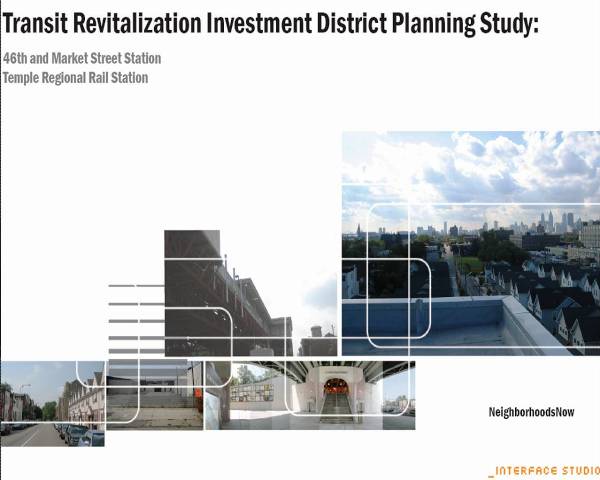How transit can transform a neighborhood

Nov. 17
By Thomas J. Walsh
For PlanPhilly
The first “transit revitalization investment district” (TRID) studies for Philadelphia locations since a 2004 state act initiated the possibility of such areas have been published by NeighborhoodsNow, a nonprofit developer of market-driven programs aimed at improving the city’s low- and moderate-income neighborhoods.
The studies focused on areas within a half-mile radius of two underused, down-at-the-heels SEPTA regional rail stations – at Temple University at 9th and Berks Streets in North Philadelphia, and the El at 46th and Market streets in West Philadelphia.
The TRID Planning Study was introduced at a late afternoon reception on Nov. 13 at the Center for Architecture in Center City. Giving an overview of the studies were representatives of the partners who developed the study, which was funded by the city and the state’s Department of Community and Economic Development (DCED).
Transit-oriented development, or TOD, has been elevated lately as a concept because it is tied closely to infrastructure issues, said Lee Huang, director of University City-based Econsult Corp., but also because cities have seen a residential resurgence in recent years for people of all incomes. TRIDs provide affordability, access and aesthetics to areas “where a city and a management agency can work together” toward what he called “value capture.”
Huang said TRIDs can be thought of as similar to “transit-oriented TIFs.” (TIFs, or “tax increment financing” zones, exist where incremental taxes are captured and set aside to for specific long-term projects, such as floating a bond for infrastructure improvements.)
TRIDs would use the same principles and mechanisms of a TIF, upfront funding and the power of a Commonwealth-given priority status, Huang said. The difference is that TIFs capture taxes only on specific sites, while TRID districts can go out as far as the half-mile radius.
“Potential real estate growth around neighborhood transit stations is stymied by zoning limitations, undesirable land uses including long-term vacancies, and safety concerns,” wrote Beverly Coleman, executive director of NeighborhoodsNow, in the introduction to the TRID Planning Study. “As Boston, Washington D.C., and other cities demonstrate, TOD can serve as a very effective approach for capitalizing on transit assets to increase housing opportunities; provide access to jobs and retail centers; and improve the safety and appearance of neighborhoods.” (The study’s PDF is here: http://www.neighborhoodsnowphila.org/pdf/trans-rev-study.pdf .)
‘We have a rail station?’
Scott Page, founder and principal of Interface Studio LLC, stressed neighborhood communication and empowerment as fundamental for TRIDs to work. He outlined goals and positions identified by Interface to bring the plans to fruition:
• Extend the presence of the rail stations by improving the basics, such as better access, security cameras, lighting and police bike patrols. A loftier aspiration would be changing the culture of driving.
• Information is power. Better signage and “real-time” information for users is one thing. Another is letting people know that there is a rail station in their neighborhood to begin with. Page said it was surprising how many people, when polled, asked, “What rail station?”
• It’s not just about the rail, Page said. Interconnectivity with buses and the El or the Broad Street subway are important, along with safe bicycle parking, car-sharing and “kiss and ride” areas (where spouses or children can be dropped off in specially designated non-parking zones).
• Activity injection. New park spaces, farmers’ markets and “running blocks” (literally putting running tracks around desolate or low-activity blocks, like the “superblocks” north of Market Street near 46th).
• Lead people to the stations. Color coded bike paths and trees do wonders, he said.
• Increase visibility by extending, conceptually, the station in any number of ways.
• Upgrade and re-use the infrastructure. Create “small, intense parks” for rain gardens or locally generated nurseries.
• Develop. By adding retail and / or mixed commercial and residential space, density increases.
The 2004 TRID Act, backed by the Delaware Valley Regional Planning
Commission (DVRPC), enabled municipal governments and transit authorities to more effectively coordinate transportation infrastructure, land use and development. The thinking is that by providing incentives for TOD in general, community involvement in development will flourish. The act also gives priority for grants and technical assistance through the state DCED. This allows municipalities to “capture the value” of new development, the concept Huang stressed.
“Our role is to bring these ideas together,” said Thomas Webster, chairman of NeighborhoodsNow and chief operating officer of The Gabriel Institute, a Center City management assessment firm.
Also speaking Thursday was Byron Comati, SEPTA’s director of strategic planning and analysis; and Stephen Buckley, with the city’s Office of Transportation and Utilities.
NeighborhoodsNow is the second incarnation of the Philadelphia Neighborhood Development Collaborative (PNDC), which provided operating and capacity-building support to community development corporations for more than a decade, helping CDCs develop about 1,900 housing units estimated at $136 million.
Contact the reporter at tom@thomasjwalsh.info.
ON THE WEB
NeighborhoodsNow: http://www.neighborhoodsnowphila.org/
WHYY is your source for fact-based, in-depth journalism and information. As a nonprofit organization, we rely on financial support from readers like you. Please give today.





